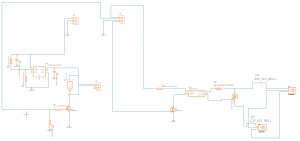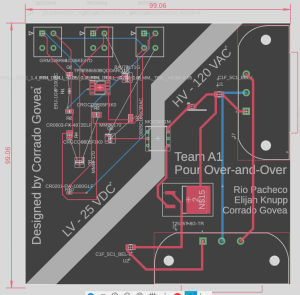Pour-Over-And-Over Video!
Corrado Govea’s Status Report for April 27th
This week’s accomplishments
- Prepared and gave the final presentation on Monday for our project.
- Continued testing and debugging of our system.
- Specifically, found some issues with the pump’s mosfet circuit where the mosfet was getting very hot even with a heatsink, so I redirected a fan that uses power directly from the gantry’s power supply.
- I helped debug the script used to control the heating and dispense, which was giving us some trouble when running everything together.
- Met with the team to discuss next steps and labor division for the remaining tasks (poster, final report).
Next Week’s Deliverables
- Finish fixing the current issues with the pump to make it more reliable — this will require extensive testing, but also lots of debugging to figure out what may be causing it to stop working sometimes.
- I will cover the testing and hardware implementation sections of the poster.
- Make an enclosure for all the electronics to sit in the gantry.
- Haven’t fully decided the labor division for the final report, but will be working on my parts once we meet to determine this.
Status Report: On Schedule
Corrado Govea’s Status Report for April 20th
This week’s accomplishments
- Spent many hours debugging the HV and LV circuits this week with Elijah!
- Assembled, probed, integrated and tested the HV power management PCB to control the heating element, with passing test results.
- Integrated the DC pump with the new power mosfet.
- Identified an issue with the circuit, where we were providing 5V to power the pump, but didn’t realize that there was also a voltage drop across the MOSFET:
- (1ohm) * (2A) = 2V drop across MOSFET.
- Solution: Increased DC supply to be 7V (5V pump + 2V MOSFET)
- (1ohm) * (2A) = 2V drop across MOSFET.
- Identified an issue with the circuit, where we were providing 5V to power the pump, but didn’t realize that there was also a voltage drop across the MOSFET:
- Completed testing for pouring water and for heating water with the team.
- Worked on final presentation.

Next Week’s Deliverables
- Continue integrating all systems and complete remaining testing.
- Ensure stability of new pump circuit, tune circuit by ensuring that gate current limiting resistor and gate discharge resistor values are appropriate through further testing.
- Add safety features to the gantry: cover to protect users from boiling water, securing all LV and power electronics to the gantry.
Status Report: On Schedule
Team Status Report for April 6th
This week, the team worked on full system integration leading up to our internal “MVP” — that is, all systems work to some extent, but all working together. The Kettle + PID loop and the 3D gantry can be controlled wirelessly, and we got a new pump, characterized it, and verified that it has enough power to prime itself.
At this point, all major systems are in an operating state, so next week we will work on assembling everything together so that we can start tuning the controls — this is important, as factors like height difference between the water reservoir and the nozzle can have an impact on flowrate.
The highest risk at the moment is ensuring that our current design meets the design requirements — for that reason, as we tune, we will start checking off on most of these requirements so that we can identify early if anything needs to be modified.
Extra: note on System Validation
We need to ensure that our product, as defined by our design requirements, meets the use case requirements that we defined early on in the semester. To do this, we plan on creating a simplified survey with a clear, measurable metric for each of our use case requirements, and we will try to collect as much field data as possible to determine if there are any areas that need to be improved from the consumer’s side.
Corrado Govea’s Status Report for April 6th
This week’s accomplishments
- Finished debugging the LV circuit.
- Identified issue with LDO voltage regulator not being able to handle the heat generated (Max 150 deg C)
- Currently .2A * 18V * ~50degC = 180 deg C
- Solution: We switched to a new pump, which is rated for 5V and 2A. Coincidentally, the power strip we got has a usb port rated precisely for 5V 2A, so we can power the pump directly from there. I need to get a new mosfet that is rated for this current to regulate the voltage drop across the pump.
- Identified issue with LDO voltage regulator not being able to handle the heat generated (Max 150 deg C)
- Continued debugging HV AC circuit.
- Currently only able to turn on/off — can’t regulate voltage at the output.
- Changed current limiting resistor to match optocoupler’s specification, but this still didn’t solve the issue.
- Was able to change the resistance across the output of the optocoupler by changing the voltage at the input, but the current delivered to the kettle is the same.
- Characterized new pump.
- Conducted test to characterize voltage across pump vs flow rate. The flow rate is a bit higher than we need, so we will design a flow restrictor to bring down to our desired rate. Pump seems suitable for our needs.

Next Week’s Deliverables
- Order new components (Monday) to match circuit design changes, and decide if it will be necessary to order a new PCB, or if we can repurpose the ones we received.
- If not, order new PCB by Wed at the latest.
- Continue to debug HV side to determine what is preventing from doing voltage regulation at the triac.
Extra: System Verification
- I plan to verify the pump controller circuit + code by running this test:
- After the entire system is installed, I will place a cup on the machine with a scale we have been using that has a flow meter in g/s. This way, I can verify that the set flow rate and actual flow rate are within the defined margins.
- To verify the heating element:
- our max expected heating time will be 3:30min, so we will run 5, 4-min trials where we set a desired temperature and monitor the water temperature to make sure it is within 5degF of the set temp. This will be tested at the outlet to account for heat loss through the pipes.
- Additionally, I will add a multimeter to the circuit to ensure that we are delivering current to the kettle as expected.
Status Report: On Schedule
Corrado Govea’s Status Report for March 30th
This week’s accomplishments
- This week I received the components and PCB that I ordered for the power management board.
- I built the circuit and tested it, but ran into a few issues.
- For some reason, the MOSFET section of the LV circuit is not working — that is, I am able to step down the 24V to a constant 6V for the pump, but then when I try to modulate the 6V with a MOSFET + PWM signal from the Pi, the voltage at the pump is inconsistent and very low. Still debugging.
Next Week’s Deliverables
- Finish debugging the circuit and integrate it with the PID loop algorithm for the kettle/heating element.
- Make any necessary modifications to the PCB after debugging — hopefully without ordering a new board (changing resistor values, etc).
Status Report: 1 week behind schedule. Plan to get back on schedule by completing the circuit debugging this week. This should be ok as I left some buffer for debugging, but want to make sure I resolve all major issues as soon as possible so they don’t block any of the integration work with the rest of the team.
Corrado Govea’s Status Report for March 23rd
This week’s accomplishments
- This week I made some major modifications to the power management PCB.
- Initially, I had designed a special circuit to do zero-crossing detection for the triac. This would require having a separate Arduino code to handle the zero-crossing detection and actuate the triac gate.
- After some research, I found a newer version of the triac driver that I had selected, which has zero-crossing detection incorporated. This allowed me to remove the entire detection circuit.
- I also re-did the layout with much thicker traces for the HV side of the board, and changed some components that were not rated for 120VAC.
- Lastly, I compressed the layout in size to reduce the PCB cost from >$60 to just $2 for qty 5.
- Initially, I had designed a special circuit to do zero-crossing detection for the triac. This would require having a separate Arduino code to handle the zero-crossing detection and actuate the triac gate.
- I also submitted the purchase forms for both the PCB and the components (smd for pcb and through-hole for prototyping).


Next Week’s Deliverables
- Write Arduino code to control the kettle and pump.
- Test prototype circuit when components arrive.
- Reflow one board and test.
Status Report: On schedule
Corrado Govea’s Status Report for March 16th
This week’s accomplishments
- This week I finished the schematic for the power management circuitry.
- This includes the new Triac circuit for controlling the PID on the kettle.
- This also includes adding a transistor to control PWM DC voltage regulation for the DC pump.
- Selected all components from Mouser and created a BOM to order the components.
- This includes both SMD and Through-hole for prototyping.
- Completed the ethics assignment and thought of ways to make better decisions on our project’s design.
Next Week’s Deliverables
- Place Mouser order for all components of PCB.
- Place PCB order.
- Meet with the team for ethics assignment and discussion.
- Start working on arduino code for controlling the new circuits on the PCB.
Status Report: On schedule
Team Status Report for March 1st
This week, the team focused on finalizing the design report document (attached to this post). This also drove us to polish some of our designs and plans for the next few weeks.
A byproduct of this work is that we finalized our testing strategy by writing down a step-by-step spec for each test that we plan to conduct.
Additionally, we received the majority of our project’s order for parts, and we started assembling/inspecting internals for some parts. This includes the 3D printer gantry (which is being assembled), the water kettle (which we took apart in order to modify the circuit for custom controls), the water pump (which we tested with a DC power supply), and others. We noted that varying the amount of current supplied to the pump proportionately affected the flow rate. We will have to do further testing to determine exact relation between the two.
The biggest challenge possibly coming up is with integration of off-the-shelf components. From what we’ve looked at so far, there are no major indicators that anything wouldn’t work, but we will not be sure of this until we’ve reached full system integration. To mitigate this risk, we plan on doing as much assembly work as possible this coming week such that, if anything doesn’t work, we can order replacements.
Schedule is currently on track.
Design report: Team_A1_Knupp_Govea_Pacheco_proposal

